In the trucking industry, it is too easy to get stuck in unpaid payments and invoice nightmares that can disrupt your business operations easily. Therefore efficient trucking invoices are crucial to run operations smoothly maintaining open communication with clients. Managing finances or expenses can be a hefty task in trucking. Still, with the right invoice management software you can pay invoices on time, keep track of the trucking invoices in PDF, and minimize billing errors easily.
In this blog, we will talk in detail about trucking invoices, their types, importance, and key features that can help trucking companies streamline their operations.
What is a trucking invoice management
Managing invoices is a business function related to procurement, managing, and processing invoice documents from vendor to supplier. Creating invoices manually is a time-consuming process, therefore it can lack clarity and professionalism losing track of important information.
The best way to manage trucking invoices is to use a TMS designed with an AI invoice management feature to help create a simple and interactive billing template with all important details. Using invoice management software you can ensure to follow compliance and regulations.
Components of trucking invoice
Carrier and freight invoices are different from each other. Both have different templates and information varies as well. However, there are specific elements in a freight invoice that are part of the trucking invoices as per the Department of Transportation’s federal motor carrier safety regulations:
- The consignor and consignee name i.e. shipper and carrier
- Shipment date
- Origin and destination of the shipment
- Quantity of packages
- Freight description
- Freight’s volume, weight, and measurement
- Exact rate(s) assessed
- Due charges
- Transportation route and name of the carrier
- Transfer point(s) if any
- Address of bill issuer’s place of business
Types of invoices used in the trucking industry
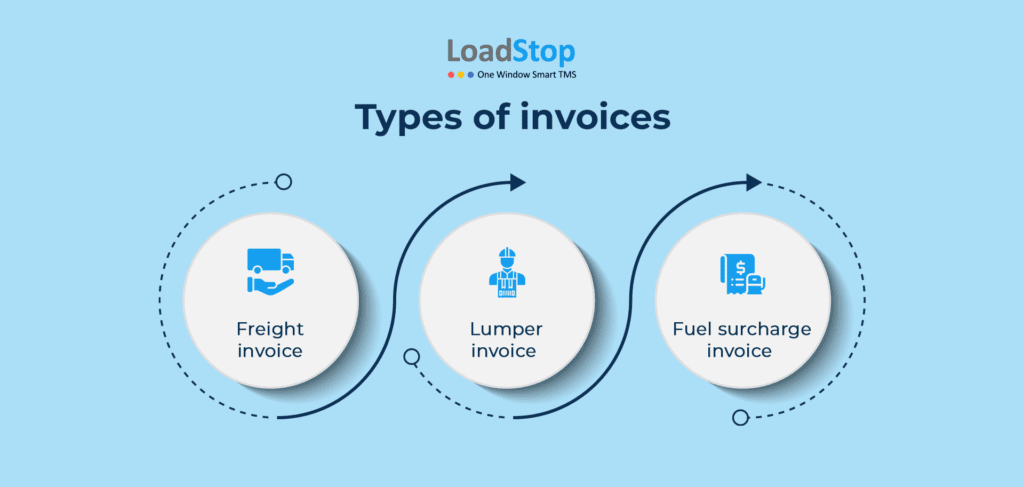
1. Freight invoices
Freight invoices thoroughly describe the services delivered, including the origin and destination, shipment information, costs, and any extra fees. They serve as an essential financial document for both the customer and the trucking company and are a foundation of billing for transportation companies.
2. Lumper receipts
When trucking companies handle the loading and unloading cargo costs at a warehouse or distribution center, lumper receipts are used. These receipts are the payment proof for additional services for instance a third-party labor involved in loading or unloading the freight. A proper receipt is shared with the client for accurate invoicing.
3. Fuel surcharge invoices
Fuel costs vary based on factors such as market trends, accidents, traffic blocks, and scheduled route choices. To keep track of extra fuel costs, a fuel surcharge invoice helps the trucking company to recover these expenses. Additional fuel charges are calculated and charged to the base of the transportation rate to balance the fuel cost fluctuation.
Importance of invoice management software for trucking companies
Efficient invoicing helps trucking companies to avoid delays and errors that can impact the cash flow. Using invoicing management software is crucial for:
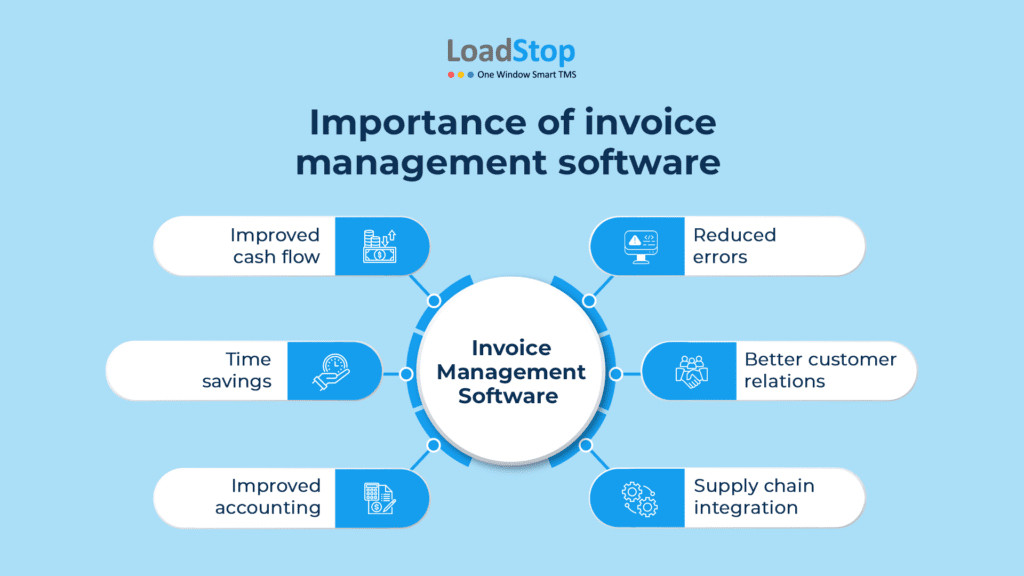
1. Improved cash flow
Delayed payments in the trucking industry can cause cash flow issues especially when it concerns fuel costs, maintenance, and payroll. Steady cash reserves are required to fulfill these recurring expenses. With the help of invoice management software, the billing process speeds up hence automation saves time and reduces payment cycles to run operations smoothly.
2. Reduced errors
Ever had trouble calculating incorrect amounts in the billing? Duplicate billing and missing details are common invoice management challenges. Such common errors can delay payments and may also harm your relationship with customers. Trucking invoice automation minimizes the risk of manual data entry and is designed with built-in validations. Accurate details in invoices also reduce disputes and misunderstandings in terms of total expense.
3. Time savings
Imagine managing multiple invoices in a matter of hours. Using an automated AI invoice management automates repetitive tasks, and generates invoices based on the completed trips, contracts, and high-value activities freeing up administrative time.
4. Better customer relations
Clean, simple, and easy-to-follow invoice templates build trust and reflect a company’s attention to detail. Invoicing software ensures invoice templates are accurate, consistent, and aligned with customer expectations. Customers can view the billing history through their portal improving the overall financial transparency and improving their experience with your business as well.
5. Improved accounting
More than often, multiple invoices, payment status, and managing credits become overwhelming without a proper accounting system. Integrating a trucking invoicing system simplifies the bookkeeping process, and ensures accurate financial reporting. You can easily streamline tax preparation once reports are generated helping you to stay compliant with financial regulations.
6. Supply chain integration
In logistics management, integrating the supply chain with invoicing is an efficient way to ensure a streamlined cash flow. A detailed record of transportation costs is beneficial in financial planning and budgeting. This integration facilitates improved communication between shippers, carriers, and clients to keep all involved parties informed about logistic costs.
6 Common challenges in trucking invoices
Freight invoicing can be optimized once the issues are identified in invoice management. Carriers and brokers encounter several challenges in preparing trucking invoices including:
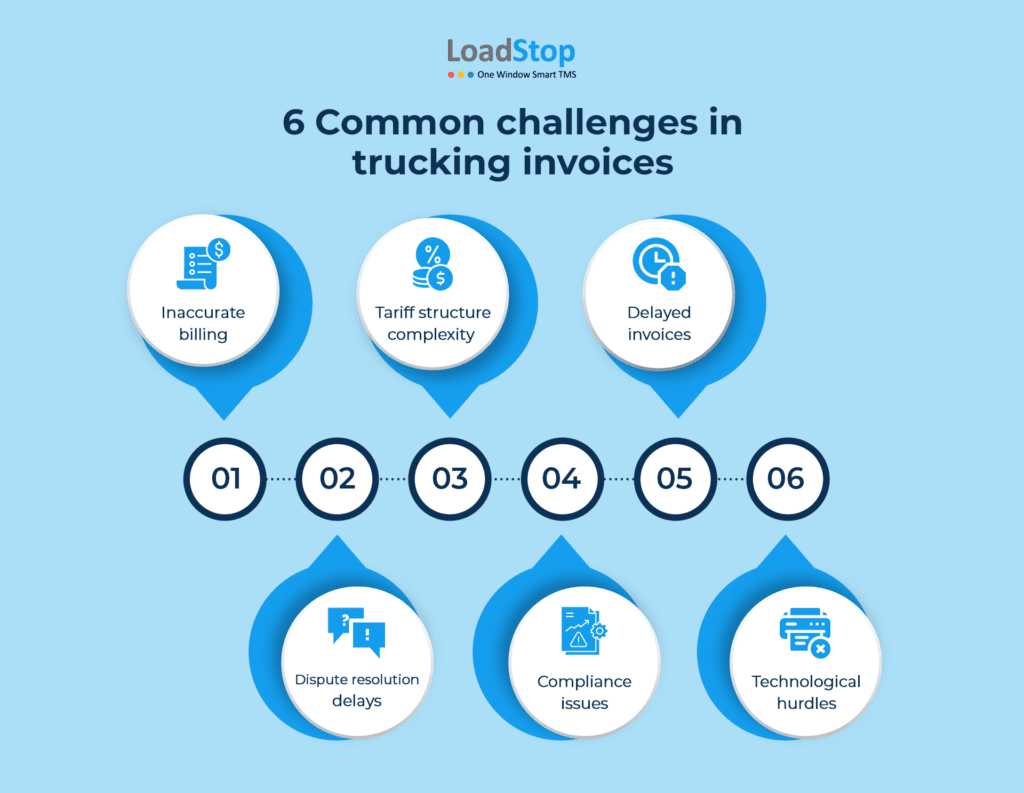
1. Inaccurate billing
Inaccurate charges frequently result from differences in weights, dimensions, and services. To address this, data must be rigorously verified before invoicing.
2. Tariff structure complexity
Confusion may result from the many and intricate tariff arrangements used in freight transportation. This problem can be lessened by making tariff structures simpler and making sure that all communications are clear.
3. Delayed invoices
Cash flow and customer relations are harmed by late invoicing. Timely invoice creation can be facilitated by the implementation of automated solutions.
4. Dispute resolution delays
Resolving invoice disputes frequently takes time. It is essential to set up an effective and transparent dispute resolution procedure.
5. Compliance issues
It might be difficult to stay in compliance with evolving regulations. It is crucial to provide regular training and updates on regulatory changes.
6. Technological hurdles
Efficient invoicing is hampered by outdated systems. Purchasing contemporary invoicing software can expedite the procedure.
Primary AI invoice management features in a TMS
Using an advanced cloud-based TMS that offers AI invoice management is a powerful tool to have. It automates and optimizes the invoicing processes. The AI-powered trucking invoice feature takes the billing to next level with:
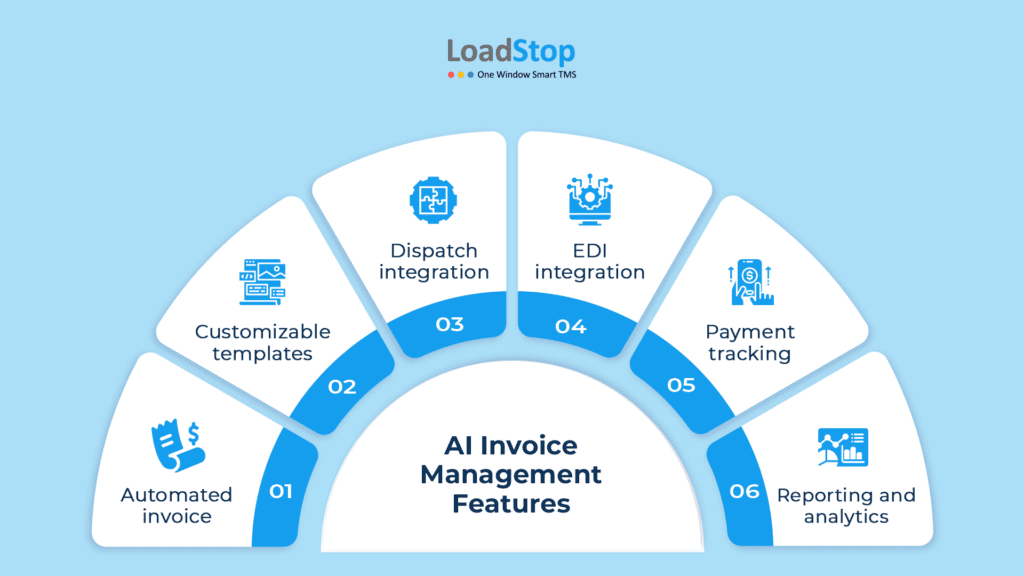
1. Automated invoice
The invoice covers the details of the loads and deliveries extracted from load dispatch. It eliminates the need to manually insert details in the invoice template. The AI-driven invoicing feature automatically pulls details of load tracking, driver’s schedule, and more to generate the invoice. Therefore real-time invoicing eliminates the delays and ensures faster payment cycles to boost cash flow.
2. Customizable templates
A trucking invoice with a proper format leaves a lasting impression on clients. If you are conscious about brand identity, you can customize the template by adding logos, custom fields, or specific terms. The invoice software comes with an easy-to-use design enabling trucking companies to meet client expectations.
3. Dispatch integration
Load dispatch is one of the most important details covered in the invoices. The invoicing software pulls data like load numbers, time of delivery, miles covered, etc. The dispatch operations are synced with the invoice management software for accurate and complete data.
4. EDI integration
The electronic data interchange allows trucking companies to send invoices to customers directly without the need to depend on emails. A cloud-based TMS supports EDI, to streamline information between businesses and clients and accelerates payments.
5. Payment tracking
Tracking payment is easier, especially if it’s an outstanding invoice, the due date is near, or you want an update on payment status. The AI invoice management system gives real-time insights into all receivables so businesses can track delayed payments and send automated reminders to clients.
6. Reporting and analytics
For a deeper insight into financial performance, using an AI TMS offering AI invoice management is helpful. You can easily generate reports, take a look at payment cycles, and extract the data you need enabling you to make informed decisions. So whether you want to review monthly revenue or expense, or highlight slow-paying clients, you can do so with the reports.
How to implement invoice management software
1. Assess your business needs
Before you implement a new invoice management software for your trucking business, you need to assess the areas of improvement and identify the pain points such as delayed payments, and consistent errors. Ensure you understand the features you want like automated reminders, customizable invoice templates, or integration with dispatch – so that it adds value.
2. Implement an automated invoicing system
Streamlining your invoicing process with automation guarantees faster payments lowers errors, and streamlines processes. Start by choosing software that meets the requirements of your trucking company and has features like dispatch integration, automated reminders, and customized templates.
Set up the system to automatically create bills based on completed trips, using information from Bills of Lading (BOL) and dispatch records. Your team can effectively manage follow-ups with the support of real-time payment tracking, which gives visibility into invoice status. Accurate bookkeeping is ensured by integration with accounting software, and automated modifications promptly reflect any changes in services, maintaining accurate and operationally aligned invoicing.
3. Include stakeholders
Collaboration amongst several departments, including accounting, dispatch, operations, and management, is necessary while implementing new software. Early involvement of these parties guarantees that the solution meets the needs of all parties. Using LoadStop, for instance, will ensure a seamless and optimized workflow to help make the invoicing process easier.
4. Provide training to staff
Effective training is necessary to optimize the potential of even the most user-friendly software. To guarantee that dispatchers, accountants, and other users are at ease using the system, provide them with practical training sessions. With the right direction, your staff can take advantage of cutting-edge capabilities like automated invoice production, real-time payment tracking, and reporting tools, which will increase operational efficiency.
5. Use detailed invoices
The invoice details depend on the truck dispatch information. The following information needs to be included on the invoice:
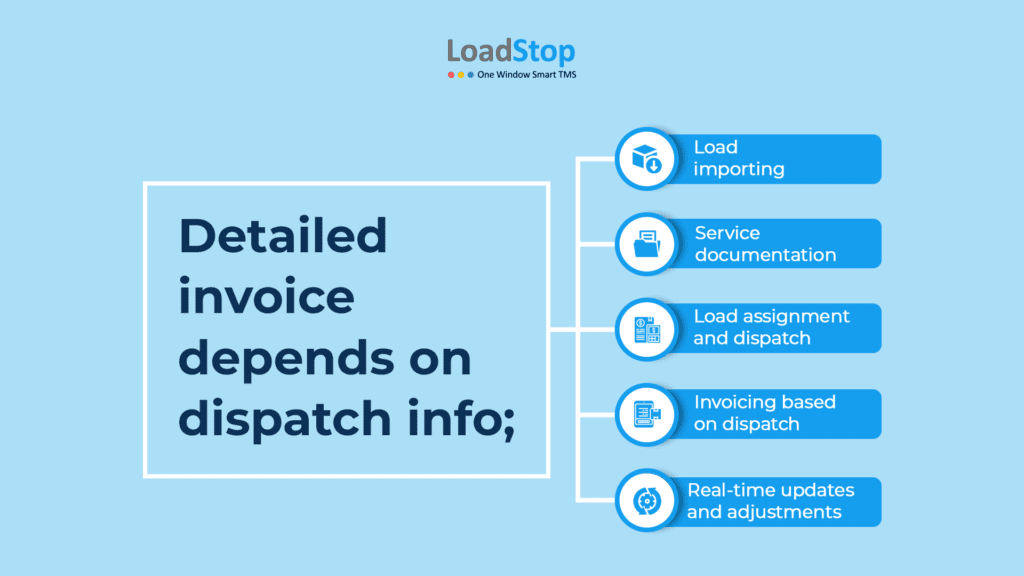
1. Automate load importing
A single click should be sufficient to input load data or rate con information into your system; human intervention should only be necessary in extreme circumstances. You have finished the first step of creating your final invoice once you have uploaded this data.
2. Load assignment and dispatch
Dispatchers then distribute loads to drivers according to many factors, including location, driver availability, and customer requirements. This step lays the groundwork for billing by outlining the services that must be rendered.
3. Service documentation
Drivers gather the necessary paperwork, such as Bills of Lading (BOLs) and proof of delivery, when they finish the cargo they have been assigned. These documents confirm that the services were provided as promised. For the billing and invoicing process that follows, this paperwork is essential.
4. Invoicing based on dispatch
The invoicing procedure is based on dispatch records, which include load information, distances traveled, and any extra services rendered. Precise dispatch data guarantees that bills accurately represent the services provided, resulting in clear and uncontested invoicing.
5. Real-time updates and adjustment
Real-time modifications to load information are possible with dispatching software that is coupled with invoicing, and the invoicing can instantly reflect these updates. This feature is essential for handling modifications to load requirements, extra fees, and guaranteeing that bills are always correct.
6. Review the invoice
Your invoicing requirements may change over time due to the dynamic nature of the transportation industry. To make sure the invoice management software is still meeting your business needs, evaluate its performance regularly.
Utilize the analytics features of the software to pinpoint areas that need work, such as cutting down on late payments or streamlining billing cycles. Frequent feedback loops and upgrades help you maintain system functionality and make sure it adjusts to evolving company needs.
Pay trucking invoices on time without delays
Freight invoicing is an essential procedure that guarantees efficiency and transparency in the transportation of products; it goes beyond simply creating bills.
Adopting technology-driven solutions, such as invoice automation from LoadStop, will become more and more important as the trucking business develops. You may improve your trucking company’s financial stability, client connections, and success by utilizing automation, centralized data management, and accurate invoicing.
Turn Dispatch into Dollars – AI That Sends Invoices at Full Speed!
Book Your DemoFAQs
Provide a detailed description of each available transportation service, including the date, route, and kind of service. Indicate the rate per unit, the amount of service rendered, and the pricing method (per mile, per hour, per ton, etc.) in clear terms. Include any extra fees and taxes in your summary of the overall expenses.
Using an advanced cloud-based transportation management system like LoadStop you can send trucking invoices easily to the customers and set payment reminder alerts.
All transportation charges should be paid within 7 working days from the date of shipment was delivered at the drop-off location. However, it does not include the weekends or legal holidays



